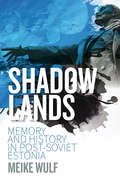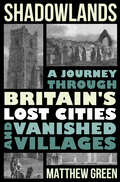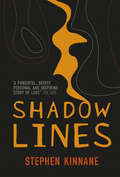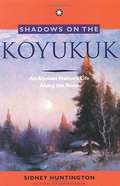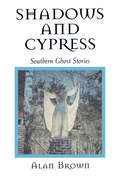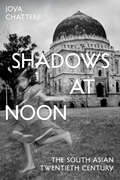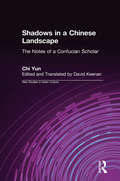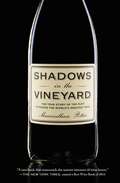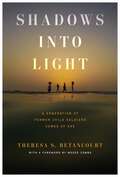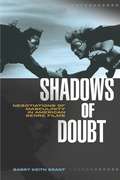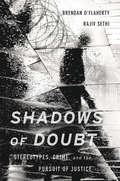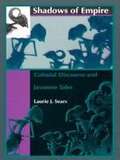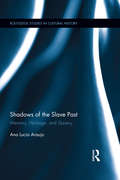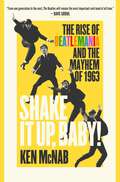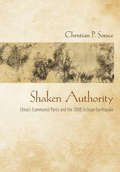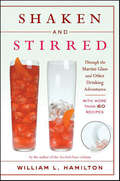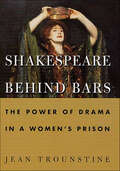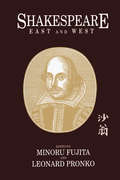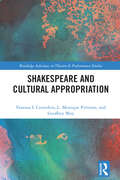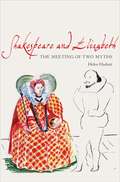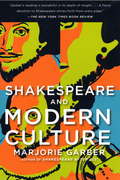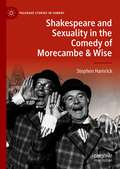- Table View
- List View
Shadowlands
by Meike WulfLocated within the forgotten half of Europe, historically trapped between Germany and Russia, Estonia has been profoundly shaped by the violent conflicts and shifting political fortunes of the last century. This innovative study traces the tangled interaction of Estonian historical memory and national identity in a sweeping analysis extending from the Great War to the present day. At its heart is the enduring anguish of World War Two and the subsequent half-century of Soviet rule. Shadowlands tells this story by foregrounding the experiences of the country's intellectuals, who were instrumental in sustaining Estonian historical memory, but who until fairly recently could not openly grapple with their nation's complex, difficult past.
Shadowlands: A Journey Through Britain's Lost Cities and Vanished Villages
by Matthew GreenOne of Literary Hub's Most Anticipated Books of 2022 A “brilliant London historian” (BBC Radio) tells the story of Britain as never before—through its abandoned villages and towns. Drowned. Buried by sand. Decimated by plague. Plunged off a cliff. This is the extraordinary tale of Britain’s eerie and remarkable ghost towns and villages; shadowlands that once hummed with life. Peering through the cracks of history, we find Dunwich, a medieval city plunged off a cliff by sea storms; the abandoned village of Wharram Percy, wiped out by the Black Death; the lost city of Trellech unearthed by moles in 2002; and a Norfolk village zombified by the military and turned into a Nazi, Soviet, and Afghan village for training. Matthew Green, a British historian and broadcaster, tells the astonishing tales of the rise and demise of these places, animating the people who lived, worked, dreamed, and died there. Traveling across Britain to explore their haunting and often-beautiful remains, Green transports the reader to these lost towns and cities as they teeter on the brink of oblivion, vividly capturing the sounds of the sea clawing away row upon row of houses, the taste of medieval wine, or the sights of puffin hunting on the tallest cliffs in the country. We experience them in their prime, look on at their destruction, and revisit their lingering remains as they are mourned by evictees and reimagined by artists, writers, and mavericks. A stunning and original excavation of Britain’s untold history, Shadowlands gives us a truer sense of the progress and ravages of time, in a moment when many of our own settlements are threatened as never before.
Shadowlines
by Stephen KinnaneA powerful and lyrical work by a writer of vision and imagination, Shadow Lines is the story of Jessie Argyle, born in the remote East Kimberley and taken from her Aboriginal family at the age of five, and Edward Smith, a young Englishman escaping the rigid strictures of London. In a society deeply divided on racial lines, Edward and Jessie met, fell in love and, against strong opposition, eventually married. Despite unrelenting surveillance and harassment, the Smith home was a centre for Aboriginal cultural and social life for over thirty years.
Shadows On The Koyukuk: An Alaskan Native's Life Along the River
by Sydney Huntington Jim ReardonJim Reardon: "Shortly after 1900, Klondike gold rusher James S. Huntington wandered down the Yukon River, where he met and married Anna, a Koyukon daughter of the land. Their son Sidney has now lived for three-quarters of a century in the Koyukuk country where he was born. His life's story is a fascinating slice of Alaskan history. Sidney grew up in a subarctic wildland of birchbark canoes, dog teams, trappers, gold miners, and Koyukon Indians. He continues to live in essentially the same culture, now modernized with snow machines, bush planes, and satellite TV. He is a product of the land, who thoroughly knows his region, the animals, and the people who live there. The memories he shares in this book bring alive a way of life that is gone forever, for as a teenager and young man he lived primarily off the land; his interest in traditional Koyukon tales provides an intriguing peek into Koyukon Indian prehistory. In addition to leading an incredibly adventurous life, Huntington is a special kind of person. His is a bootstraps-up, inspirational success story of survival. Despite this, Sidney has always found time to help others-a trait that in recent years has brought him statewide respect and an honorary doctorate from the University of Alaska. Long before he received that degree, I regarded Sidney as holding a doctorate in life, for he is self-educated, with knowledge that extends far beyond the horizons of Alaska's Koyukuk country." Note to parents: a few hells and damns pepper the dialogue in this book.
Shadows and Cypress: Southern Ghost Stories
by Alan BrownFrom backwaters as dark as a cypress swamp to nooks as mysterious as a musty college library, southerners have conjured spirits and told ghost stories. Shadows and Cypress: Southern Ghost Stories is a Dixie séance that summons ghost tales from Alabama, Arkansas, Florida, Georgia, Kentucky, Louisiana, Mississippi, North Carolina, South Carolina, Tennessee, Texas, and Virginia. Collecting more than a dozen stories from each state, this book channels the South's entire panorama of creepy locales into one volume. The limestone caves of Kentucky, the swamps of Louisiana and Florida, the pine hills and hollows of Appalachia, and the plains of Texas—these are perfect haunts for a host of narratives about visitors from the spirit world. The many cultures that converged in the American South enriched the region's ghost stories. Shadows and Cypress taps African American, French, Hispanic, and Scotch-Irish storytelling traditions to capture the distinctive signatures that each has left on ghostlore. Throughout the region, the southern ghost story is hardly a curio from the crypt. It is still alive and well. Folklorist Alan Brown draws stories from crannies as contemporary as the college dormitory or cars parked on a lover's lane. To give the reader the unique experience of hearing a classic ghost story told, Brown presents these tales exactly as they were recorded in his field research or as archived in the trove of the WPA oral collections. A wide variety of specters found only in this region arise in Shadows and Cypress. The “fillet” and “loogaroo” from Louisiana, “plat-eye” from South Carolina, and “haints” from across Dixie are among the creatures bumping in the night. Beginning with the Revolutionary War and continuing to the present day, this generous gathering of tales will chill and delight readers and long haunt shelves as a comprehensive sourcebook of the region's supernatural allure.
Shadows at Noon: The South Asian Twentieth Century
by Joya ChatterjiA groundbreaking view of South Asian history in the twentieth century that underlines the similarities and intertwined cultures of India and Pakistan “[A] definitive new 20th-century thematic history of the Indian subcontinent that rejects hegemonic conceptions of national ‘difference.’”—Financial Times This radically original and ambitious history of the Indian subcontinent explores the region’s unique twentieth-century history and foregrounds the deep connections, rather than the well-publicized fissures, between the cultures of India and Pakistan. Taking the partitions of British India rather than the two world wars as the century’s inflection points, Joya Chatterji examines how issues of nationalism, internal and external migration, and technological innovation contributed to South Asia’s tumultuous twentieth century. Chatterji weaves together elements of her autobiography and family history; stories of such legendary figures as Tagore, Jinnah, Gandhi, and Nehru; and, in particular, the accounts of the many who were left behind and marginalized in relentless nation-building projects. Chatterji examines the countries’ mirroring patterns in state building, social and cultural life, modes of leisure, consumption, and oppression, and offers a timely course correction to our understanding of the dynamics of South Asian history. It reframes the events of the twentieth century that are continuing to play out in the present day.
Shadows in a Chinese Landscape: Chi Yun's Notes from a Hut for Examining the Subtle
by Chi Yun David KeenanIn this major undertaking David Keenan translates and contextualizes over 100 tales from the Notes from the Hut for Examining the Subtle, a collection of 1,200 tales and observations by Chi Yun, one of eighteenth century China's leading intellectuals. By illuminating neglected aspects of the interaction between popular and elite cultures in late imperial China, this study portrays the rich connection between life and letters on the eve of the Western impact.
Shadows in the Vineyard: The True Story of the Plot to Poison the World's Greatest Wine
by Maximillian PotterWhen Maximilian Potter went to Burgundy to report for Vanity Fair on a crime that could have destroyed the Domaine de la Romanée Conti-the tiny, storied vineyard that produces the most expensive, exquisite wines in the world-he soon found a story that was much larger, and more thrilling, than he had originally imagined. In January 2010, Aubert de Villaine, the famed proprietor of the DRC, received an anonymous note threatening the destruction of his priceless vines by poison-a crime that in the world of high-end wine is akin to murder-unless he paid a one million euro ransom. Villaine believed it to be a sick joke, but that proved a fatal miscalculation; the crime was committed and shocked this fabled region of France. The sinister story that Potter uncovered would lead to a sting operation by top Paris detectives, the primary suspect's suicide, and a dramatic trial. This botanical crime threatened to destroy the fiercely traditional culture surrounding the world's greatest wine. Like Midnight in the Garden of Good and Evil, SHADOW IN THE VINEYARD takes us deep into a captivating world full of fascinating characters, small town French politics, an unforgettable narrative, and a local culture defined by the twinned veins of excess and vitality and the deep reverent attention to the land that run through it.
Shadows into Light: A Generation of Former Child Soldiers Comes of Age
by Theresa S. BetancourtA twenty-plus-year study of former child soldiers offers far-reaching insight into mental health and resilience after extreme trauma.During the civil war that ravaged Sierra Leone from 1991 to 2002, an estimated 20,000 children were forced to join the fighting. As villages were raided and youths rounded up, it was not uncommon for a child to be ordered to kill a friend, relative, or neighbor under threat of being killed themselves. The goal was to make it impossible for the captives to return home and be accepted back into their communities.But when the conflict ended, many of the children did find their way home. Could they reintegrate after such extreme trauma? Theresa Betancourt and her collaborators in Sierra Leone launched a study of more than 500 boys and girls who had been pulled into the war, tracking them for over two decades. The results were surprising: despite everything they had suffered, this was not a lost generation. In fact, the most dominant trend over time was one of healing and increasing acceptance. The lives of the former child soldiers were shaped not just by their personal ordeals but also, crucially, by the responses of their families, peers, and broader communities. Filled with vivid personal stories, Shadows into Light describes heartbreak and despair but also remarkable triumphs made possible by layers of social support and encouragement.Betancourt’s study provides unparalleled insight into the long-term psychological and developmental effects of family separation, war, and exposure to violence. The lessons go far beyond Sierra Leone’s tragedy, suggesting that we should, in general, think of children’s risk and resilience more as products of the post-trauma environment than as individual traits.
Shadows of Doubt: Negotiations of Masculinity in American Genre Films
by Barry Keith GrantIn Shadows of Doubt: Negotiations of Masculinity in American Genre Films, Barry Keith Grant questions the idea that Hollywood movies reflect moments of crisis in the dominant image of masculinity. Arguing instead that part of the mythic function of genre movies is to offer audiences an ongoing dialogue on issues of gender, Grant explores a wide range of genre films, including comedies, musicals, horror, science fiction, westerns, teen movies, and action films. In ten chapters arranged chronologically according to the films discussed, Grant provides a series of close analyses of such disparate films such as Broken Blossoms, The Fatal Glass of Beer, Red River, 2001: A Space Odyssey, Night of the Living Dead, and The Hurt Locker to demonstrate that representations of masculinity in the movies involve a continuous process of ideological testing and negotiation. While some of the films considered offer important challenges to dominant representations of masculinity, others reveal an acceptance or capitulation to them. Always attentive to the details of individual film texts, Grant also places the genre films he discusses within their historical contexts and the broader contexts and traditions of popular culture that inform them, including literature, theater, and music. Scholars of film and television studies as well as readers interested in gender studies will appreciate Shadows of Doubt.
Shadows of Doubt: Stereotypes, Crime, and the Pursuit of Justice
by Brendan O'Flaherty Rajiv SethiCrime and punishment occur under extreme uncertainty. Offenders, victims, police, judges, and jurors make high-stakes decisions with limited information under severe time pressure. With compelling stories and data on how people act and react, O’Flaherty and Sethi reveal the extent to which we rely on stereotypes as shortcuts in our decision making.
Shadows of Empire: Colonial Discourse and Javanese Tales
by Laurie J. SearsShadows of Empire explores Javanese shadow theater as a staging area for negotiations between colonial power and indigenous traditions. Charting the shifting boundaries between myth and history in Javanese Mahabharata and Ramayana tales, Laurie J. Sears reveals what happens when these stories move from village performances and palace manuscripts into colonial texts and nationalist journals and, most recently, comic books and novels. Historical, anthropological, and literary in its method and insight, this work offers a dramatic reassessment of both Javanese literary/theatrical production and Dutch scholarship on Southeast Asia.Though Javanese shadow theater (wayang) has existed for hundreds of years, our knowledge of its history, performance practice, and role in Javanese society only begins with Dutch documentation and interpretation in the nineteenth century. Analyzing the Mahabharata and Ramayana tales in relation to court poetry, Islamic faith, Dutch scholarship, and nationalist journals, Sears shows how the shadow theater as we know it today must be understood as a hybrid of Javanese and Dutch ideas and interests, inseparable from a particular colonial moment. In doing so, she contributes to a re-envisioning of European histories that acknowledges the influence of Asian, African, and New World cultures on European thought--and to a rewriting of colonial and postcolonial Javanese histories that questions the boundaries and content of history and story, myth and allegory, colonialism and culture.Shadows of Empire will appeal not only to specialists in Javanese culture and historians of Indonesia, but also to a wide range of scholars in the areas of performance and literature, anthropology, Southeast Asian studies, and postcolonial studies.
Shadows of Time: Unveiling Crime, Victims, and Aging (International Perspectives on Aging #46)
by Jason PowellShadows of Time: Unveiling the Intersection of Crime, Victims, and Aging is a comprehensive exploration of the complex relationship between crime, victims, and the aging population. Whilst older people are visible as an aging population, they are invisible as a victim population or even more controversially, as an offending population. This book delves into the challenges, vulnerabilities, and unique obstacles faced by older adults who become victims of crime and offenders of crime across cultures. It is one of a tiny handful of books that explores the relationship of aging, victimization and criminality. To make sense of such issues, there will be a critical exploration of the links between theory, policy and practice. The primary purpose of this book is to shed light on the often-overlooked issue of elderly victimization and offending and to raise awareness about its impact.
Shadows of the Slave Past: Memory, Heritage, and Slavery (Routledge Studies in Cultural History #30)
by Ana Lucia AraujoThis book is a transnational and comparative study examining the processes that led to the memorialization of slavery and the Atlantic slave trade in the second half of the twentieth century. Araujo explores numerous kinds of initiatives such as monuments, memorials, and museums as well as heritage sites. By connecting different projects developed in various countries and urban centers in Europe, Africa, and the Americas during the last two decades, the author retraces the various stages of the Atlantic slave trade and slavery including the enslavement in Africa, the process of confinement in slave depots, the Middle Passage, the arrival in the Americas, the daily life of forced labor, until the fight for emancipation and the abolition of slavery. Relying on a multitude of examples from the United States, Brazil, and the Caribbean, the book discusses how different groups and social actors have competed to occupy the public arena by associating the slave past with other human atrocities, especially the Holocaust. Araujo explores how the populations of African descent, white elites, and national governments, very often carrying particular political agendas, appropriated the slave past by fighting to make it visible or conceal it in the public space of former slave societies.
Shadows of the Slave Past: Memory, Heritage, and Slavery (Routledge Studies in Cultural History)
by Ana Lucia AraujoThis book is a transnational and comparative study examining the processes that led to the memorialization of slavery and the Atlantic slave trade in the second half of the twentieth century. Araujo explores numerous kinds of initiatives such as monuments, memorials, and museums as well as heritage sites. By connecting different projects developed in various countries and urban centers in Europe, Africa, and the Americas during the last two decades, the author retraces the various stages of the Atlantic slave trade and slavery including the enslavement in Africa, the process of confinement in slave depots, the Middle Passage, the arrival in the Americas, the daily life of forced labor, until the fight for emancipation and the abolition of slavery. Relying on a multitude of examples from the United States, Brazil, and the Caribbean, the book discusses how different groups and social actors have competed to occupy the public arena by associating the slave past with other human atrocities, especially the Holocaust. Araujo explores how the populations of African descent, white elites, and national governments, very often carrying particular political agendas, appropriated the slave past by fighting to make it visible or conceal it in the public space of former slave societies.
Shake It Up, Baby!: The Rise of Beatlemania and the Mayhem of 1963
by Ken McNabA vivid, captivating account of the Beatles&’s musical transformation throughout the pivotal year of 1963, as the world became caught up in the maelstrom of Beatlemania and its far-reaching cultural impact. The Beatles broke up more than half a century ago, yet millions around the globe are still drawn to the legacy of four lads from Liverpool. From the carefree innocence of "A Hard Day's Night" to the experimental psychedelia of "Lucy In The Sky With Diamonds,&” their message of love, peace, and hope still resonates. In Shake It Up, Baby! we go back to the start—to 1963, when they went from playing in small clubs in the remote Scottish Highlands to four number one singles, two number one albums, three national tours, and being besieged by thousands of fans at gigs all over Britain. Ken McNab tells the story through gripping, exclusive eye-witness accounts from those who were there: the Beatlemaniacs, the journalists, broadcasters, and television producers who were scrambling to make sense of it all—and the other bands who could only watch in awe as the Beatles went from bottom of the bill to headline act to the biggest band on the planet, forever transforming musical history.
Shaken Authority: China's Communist Party and the 2008 Sichuan Earthquake
by Christian P. SoraceIn Shaken Authority, Christian P. Sorace examines the political mechanisms at work in the aftermath of the 2008 Sichuan earthquake and the broader ideological energies that drove them. Sorace takes Communist Party ideas and discourse as central to how that organization formulates policies, defines legitimacy, and exerts its power. Sorace argues that the Communist Party has never abandoned its conviction that discourse can shape the world and the people who inhabit it. Sorace also demonstrates how the Communist Party’s planning apparatus continues to play a crucial role in engineering China’s economy and market construction, especially in the countryside. Sorace takes a distinctive and original interpretive approach to understanding Chinese politics, and Shaken Authority demonstrates how Communist Party discourse and ideology influenced the official decisions and responses to the Sichuan earthquake. Sorace provides a clear view of the lived outcomes of Communist Party plans, rationalities, and discourses in the earthquake zone. The three case studies he presents each demonstrate a different type of reconstruction and model of development: urban-rural integration, tourism, and ecological civilization. Sorace’s work emphasizes the need for a grounded literacy in the political concepts, discourses, and vocabularies of the Communist Party itself. To dismiss China’s official discourse as "empty propaganda," Sorace argues, makes China and Chinese realities harder to understand, not easier.
Shaken and Stirred: Through the Martini Glass and Other Drinking Adventures
by William L. HamiltonWilliam L. Hamilton loves a good gimlet. Rose's and lime. Straight up. Perfectly iced. Make the glass pretty too. "It ruined my reputation for thinking before I speak," he writes of that love. "I accept the trade-off." Like Lewis Carroll's Alice, when Hamilton sees it, he drinks it -- and tells the incredible tale.In "Shaken and Stirred," his biweekly Sunday Styles column, now an original book of his drinking adventures, the intrepid New York Times reporter offers a gimlet-eyed look at contemporary culture through the panoptic view of a cocktail glass. From the venerable martini to the young Dirty Jane, Hamilton shares his tip on the sip.You hold in your hands a guide to "how it goes down." Not a cocktail manual or a Baedeker to the bar scene but a drinker's guide to drinking. These are four-ounce adventures of cocktails and the people who make them, from the bartenders and chefs to the patrons, the politicians and the power players of the liquor industry.There are tales of the Champagne high life, the Long Island Iced Tea low life; men like Dr. Brown and his celery soda, and women like Eve and her Apple Martini. Hamilton's weekly Runyanesque rounds cover all the watering holes and their poisons, from the East Side's Southside to the Incredible Hulk in the Bronx, and monitors the latest trends, from the ultra-premium vodka wars to the Red Bull market. Shaken and Stirred is a report on a popular culture that comes alive after five, when the mood turns social and the moment is sweet (or sour, or bitter, or dry).Hamilton has also picked up the best (or the most unbelievable) cocktail recipes from bars, lounges and restaurants in New York City and beyond. There is common sense and creativity in the classics, and new inventions with their eye on the prize, such as the Huckleberry Ginn and the Bleeding Heart."drink me," said the bottle in Alice's Adventures in Wonderland. Hamilton has, in every instance, and bottled his thoughts in sixty-four essays that are as readable as they are drinkable. Mix a gimlet, or a Minnesota Anti-Freeze, or a Gibson or a Bone. And spend a night in, on the town.
Shakespeare Behind Bars: The Power of Drama in a Women's Prison
by Jean TrounstineA deeply stirring account of one woman's experience teaching drama to women in prison.I began to understand that female prisoners are not "damaged goods" and to recognize that most of these women had toughed it out in a society that favors others-- by gender, class, or race. They are Desdemonas suffering because of jealous men, Lady Macbeths craving the power of their spouses, Portias disguised as men in order to get ahead, and Shylocks who, being betrayed, take the law into their own hands.So writes Jean Trounstine in Shakespeare Behind Bars. In this gripping account, Trounstine, who spent ten years teaching at Framingham Women's Prison in Massachusetts, focuses on six inmates who, each in her own way, discover in the power of great drama a way to transcend the painful constraints of incarceration. We meet:* Dolly, a fiftyish grandmother who brings her knitting to classes and starts a battered-women's group in prison*Bertie, a Jamaican beauty estranged from her homeland, torn with guilt, and shunned for her crime* Kit, a tough, wisecracking con who stirs up trouble whenever she can-- until she's threatened with losing her kids* Rose, an outsider in the prison community who lives with HIV and eventually gains acceptance through drama* Rhonda, a college-educated leader whose life falls apart when her father dies and who struggles in prison to reestablish her roots* Mamie, a nurse in the free world, now the prison gardener who makes cards with poetry and dried flowers and battles her own illness behind barsShakespeare Behind Bars is a uniquely powerful work that gives voice to forgotten women, sheds a compassionate light on a dark world, and proves the redemptive power of art and education.
Shakespeare East and West
by Minoru Fujita Leonard PronkoThe International Shakespeare Association meeting, held in Tokyo in August of 1991, was regarded by many of the participating academics as a milestone in terms of the quality of the papers given and extent to which the intercultural and cross-cultural study of Shakespeare had been developed. This volume contains the principal contributions (10) to the panel on Acting and Language in Shakespeare and Eastern Drama, specially edited for publication by Minoru Fujita who teaches at the Graduate School of Culture, University of Osaka, and Leonard Pronko, Professor of Theatre at Pomona College, Claremont, California. The papers are presented in three sections: Playhouses and Performances, Literary History, and Interpretation and Theoretical Issues.
Shakespeare and Company
by Sylvia BeachSylvia Beach was intimately acquainted with the expatriate and visiting writers of the "Lost Generation", a label that she never accepted. Like moths of great promise, they were drawn to her well-lighted bookstore and warm hearth on the Left Bank. Shakespeare and Company evokes the zeitgeist of an era through its revealing glimpses of James Joyce, Ernest Hemingway, Scott Fitzgerald, Sherwood Anderson, Andre Gide, Ezra Pound, Gertrude Stein, Alice B. Toklas, D. H. Lawrence, and others already famous or soon to be. In his introduction to this new edition, James Laughlin recalls his friendship with Sylvia Beach. Like her bookstore, his publishing house, New Directions, is considered a cultural touchstone.
Shakespeare and Cultural Appropriation (Routledge Advances in Theatre & Performance Studies)
by L. Monique Pittman Vanessa I. Corredera Geoffrey WayShakespeare and Cultural Appropriation pushes back against two intertwined binaries: the idea that appropriation can only be either theft or gift, and the idea that cultural appropriation should be narrowly defined as an appropriative contest between a hegemonic and marginalized power. In doing so, the contributions to the collection provide tools for thinking about appropriation and cultural appropriation as spectrums constantly evolving and renegotiating between the poles of exploitation and appreciation. This collection argues that the concept of cultural appropriation is one of the most undertheorized yet evocative frameworks for Shakespeare appropriation studies to address the relationships between power, users, and uses of Shakespeare. By robustly theorizing cultural appropriation, this collection offers a foundation for interrogating not just the line between exploitation and appreciation, but also how distinct values, biases, and inequities determine where that line lies. Ultimately, this collection broadly employs cultural appropriation to rethink how Shakespeare studies can redirect attention back to power structures, cultural ownership and identity, and Shakespeare’s imbrication within those networks of power and influence. Throughout the contributions in this collection, which explore twentieth and twenty-first century global appropriations of Shakespeare across modes and genres, the collection uncovers how a deeper exploration of cultural appropriation can reorient the inquiries of Shakespeare adaptation and appropriation studies. This collection will be of great interest to students and scholars in theatre and performance studies, Shakespeare studies, and adaption studies.
Shakespeare and Elizabeth: The Meeting of Two Myths
by Helen HackettDid William Shakespeare ever meet Queen Elizabeth I? There is no evidence of such a meeting, yet for three centuries writers and artists have been provoked and inspired to imagine it. Shakespeare and Elizabeth is the first book to explore the rich history of invented encounters between the poet and the Queen, and examines how and why the mythology of these two charismatic and enduring cultural icons has been intertwined in British and American culture. Helen Hackett follows the history of meetings between Shakespeare and Elizabeth through historical novels, plays, paintings, and films, ranging from well-known works such as Sir Walter Scott's Kenilworth and the film Shakespeare in Love to lesser known but equally fascinating examples. Raising intriguing questions about the boundaries separating scholarship and fiction, Hackett looks at biographers and critics who continue to delve into links between the queen and the poet. In the Shakespeare authorship controversy there have even been claims that Shakespeare was Elizabeth's secret son or lover, or that Elizabeth herself was the genius Shakespeare. Hackett uncovers the reasons behind the lasting appeal of their combined reputations, and she locates this interest in their enigmatic sexual identities, as well as in the ways they represent political tensions and national aspirations. Considering a wealth of examples, Shakespeare and Elizabeth shows how central this double myth is to both elite and popular culture in Britain and the United States, and how vibrantly it is reshaped in different eras.
Shakespeare and Modern Culture
by Marjorie GarberFrom one of the world’s premier Shakespeare scholars, author ofShakespeare After All(“the indispensable introduction to the indispensable writer”–Newsweek): a magisterial new study whose premise is “that Shakespeare makes modern culture and that modern culture makes Shakespeare. ” Shakespeare has determined many of the ideas that we think of as “naturally” our own and even as “naturally” true–ideas about human character, individuality and selfhood, government, leadership, love and jealousy, men and women, youth and age. Yet many of these ideas, timely as ever, have been reimagined–are indeed often now first encountered–not only in modern fiction, theater, film, and the news but also in the literature of psychology, sociology, political theory, business, medicine, and law. Marjorie Garber delves into ten plays to explore the interrelationships between Shakespeare and twentieth century and contemporary culture–from James Joyce’sUlyssesto George W. Bush’s reading list. InThe Merchant of Venice,she looks at the question of intention; inHamlet, the matter of character; inKing Lear,the dream of sublimity; inOthello,the persistence of difference; and inMacbeth,the necessity of interpretation. She discusses the conundrum of man inThe Tempest; the quest for exemplarity inHenry V; the problem of fact inRichard III; the estrangement of self inCoriolanus; and the untimeliness of youth inRomeo and Juliet. Shakespeare and Modern Culture is a tour de force reimagining of our own mental and emotional landscape as refracted through the prism of protean “Shakespeare. ” From the Hardcover edition.
Shakespeare and Sexuality in the Comedy of Morecambe & Wise (Palgrave Studies in Comedy)
by Stephen HamrickContextualizing the duo’s work within British comedy, Shakespeare criticism, the history of sexuality, and their own historical moment, this book offers the first sustained analysis of the 20th Century’s most successful double-act. Over the course of a forty-four-year career (1940-1984), Eric Morecambe & Ernie Wise appropriated snippets of verse, scenes, and other elements from seventeen of Shakespeare’s plays more than one-hundred-and-fifty times. Fashioning a kinder, more inclusive world, they deployed a vast array of elements connected to Shakespeare, his life, and institutions. Rejecting claims that they offer only nostalgic escapism, Hamrick analyses their work within contemporary contexts, including their engagement with many forms and genres, including Variety, the heritage industry, journalism, and more. ‘The Boys’ deploy Shakespeare to work through issues of class, sexuality, and violence. Lesbianism, drag, gay marriage, and a queer aesthetics emerge, helping to normalize homosexuality and complicate masculinity in the ‘permissive’ 1960s.
